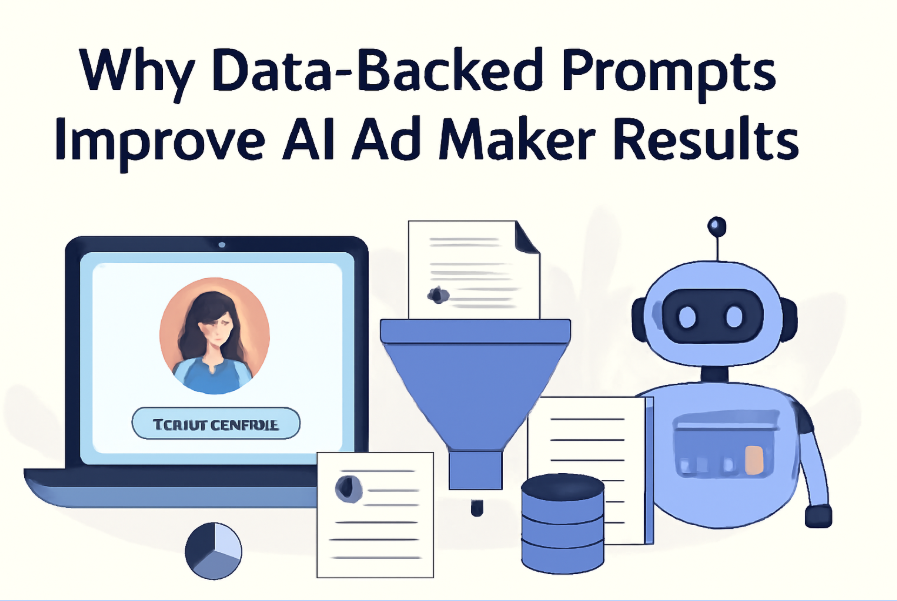The Power of Prompt Engineering in AI Ad Creation
AI ad generators are a game-changer in the marketing world, helping to speed up the ad creation process and deliver high-quality content. But here’s the thing, if you’re just feeding your AI a generic prompt like “Create an ad for a fitness app,” you’re probably not going to get the best results. The magic happens when you use data-backed prompts. These are prompts packed with specifics, think audience details, product insights, and campaign goals that help the AI understand exactly what you need.
In this post, we’ll dive into why data-backed prompts work so well and how they can totally transform your AI-generated ads. Spoiler alert: it’s all about giving the AI the right context.
echniques for Data-Backed Prompting: How to Get the Best Out of Your AI ad maker
When you want high-performing ads, what you feed your AI matters just as much as the output you expect. The secret? Data-backed prompts. By structuring and enriching your prompts with real context, you can increase accuracy, personalization, and conversion rates dramatically.
Let’s break this down step by step.
1. Use of Visual Separators to Clarify Prompt Structure
When writing prompts for your AI ad maker, clarity is everything. Visual separators like bullet points, headings, or line breaks help the AI parse your instructions more effectively.
In fact, structured prompts can improve AI comprehension by up to 31%.
Example Prompt Structure:
- Target Audience: Women aged 25–35, interested in fitness.
- Product: A fitness app with personalized workout plans.
- Call to Action: “Start your free 7-day trial today.”
This simple formatting ensures the AI clearly understands your intent.
2. Example-Driven Prompting
The AI ad maker performs even better when shown examples of what works. If you have a high-converting ad, feed it to the AI as a model.
Instead of just saying “write a fitness ad,” say:
“Generate a similar ad using these key elements: [Insert your successful ad here].”
This can increase output quality by up to 58%, giving you more targeted and persuasive ad copy.
3. Structuring Prompts for Writing Style and Flow
It’s not just what you say, t’s how you say it. The tone and flow of your prompt tell the AI ad maker what kind of voice to adopt.
Example Prompt:
- Tone: Friendly and conversational
- Style: Short, snappy sentences with a strong CTA
- Message: Highlight benefits, not just features
This ensures the AI mirrors your brand personality instead of delivering generic copy.
4. Self-Critical Prompting
Want better results without extra work? Get the AI ad maker to critique itself.
After generating an ad, ask follow-ups like:
- “Does this message resonate with the target audience?”
- “Is the CTA strong enough?”
This self-evaluation loop refines the content, making it more persuasive and aligned with campaign goals.
Benefits of Data-Backed Prompts in Ad Creation
1. Increased Accuracy and Relevance
When your prompt includes data-driven audience details, your AI ad maker can craft ads that speak directly to your ideal customer.
Example:
Targeting women aged 35–50 interested in anti-aging skincare leads to sharper, more relevant messaging.
2. Enhanced Personalization and Targeting
Data-backed prompts make personalization easy. Whether it’s demographics, interests, or behaviors, you can guide your AI to craft tailored messages that boost engagement and conversions.
3. Reduced Errors and Improved Compliance
Including guardrails like “avoid making health claims” or “add a disclaimer” helps minimize compliance issues and keeps your ads on-brand.
Practical Steps for Marketers
1. Gather and Integrate Relevant Data
Start with audience demographics, product features, campaign insights, or competitor data. The richer your input, the smarter your AI ad maker gets.
2. Create Prompt Templates for Different Ad Types
A Facebook ad often needs to be playful and conversational, while a Google Search ad should be more direct. Build reusable templates tailored to each platform.
3. Refine Prompts Iteratively
Treat your prompts like living assets. Run the first set of ads, review performance, and tweak accordingly. Small prompt refinements can lead to big performance jumps.
Real-World Examples
A/B Testing Data-Backed vs. Generic Prompts
A fitness brand ran two ads:
- Generic Prompt: “Create an ad for a fitness app.”
- Data-Backed Prompt: “Create a Facebook ad targeting women aged 25–35, focused on weight loss and offering a free trial.”
The data-backed ad generated 30% more clicks and conversions—a clear win for structured prompting.
Scaling Personalized Campaigns
A beauty brand used AI ad maker prompts tailored to different customer segments (e.g., young professionals vs. stay-at-home moms). Result: 25% higher engagement and improved ROI.
Common Pitfalls and How to Avoid Them
- Overly Vague or Complex Prompts
Keep prompts concise and focused. Too much detail can overwhelm the AI. - Ignoring Feedback Loops
Use real campaign data to refine prompts over time. - Skipping Human Review
Even the best AI-generated copy needs a human touch to ensure alignment with brand voice and compliance standards.
Unlocking AI’s Full Potential with Data-Backed Prompts

Data-backed prompting isn’t just a tactic, it’s a competitive advantage. By giving your AI ad maker clear, structured, and data-rich inputs, you can produce ads that are sharper, more personalized, and more effective.
Think of prompts not as instructions, but as your campaign blueprint. The better your blueprint, the stronger your results.




